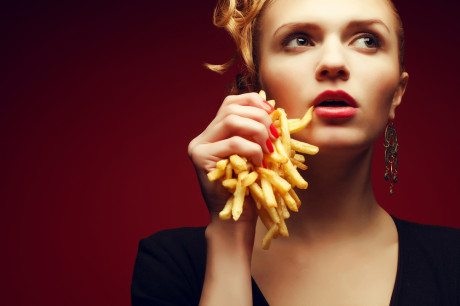5 More Incredible Facts from About the Food Industry
 Last week, we brought you five scary, disturbing, and just plain weird facts about food gleaned from Michael Moss’s excellent new book, Salt, Sugar, Fat: How the Food Giants Hooked Us. We have two more installments for you this week. Put down the fries and check out this list:
Last week, we brought you five scary, disturbing, and just plain weird facts about food gleaned from Michael Moss’s excellent new book, Salt, Sugar, Fat: How the Food Giants Hooked Us. We have two more installments for you this week. Put down the fries and check out this list:
- In 2008, a team of Dutch researches conducted an experiment. Test subjects were served foods with visible fat (bread with butter spread on it) and invisible fat (bread with baked-in butter). The people eating the food with hidden fat were hungrier and ate more, while the people eating the visible fat said they got fuller faster.
- When the army was creating MREs (Meal Ready to Eat), their research showed that big, distinct flavors can overwhelm the brain, making you feel full more quickly, something called sensory-specific satiety. Manufacturers used this discovery to create foods that pique taste buds without delivering the strong flavor that tells you to stop eating. So you won’t stop eating.
- In the late 1800s, John Harvey Kellogg opened a health complex in Michigan to promote a healthy lifestyle for Americans. He worried about Americans’ dependence on high-fat breakfasts like eggs and meat, so he created a boiled, shredded wheat food to serve to his patients. One day, while Kellogg was out of town, his brother Will put sugar into a batch of shredded wheat. Everyone loved his “Kellogg’s Toasted Corn Flakes,” and sweetened breakfast was born. The story exemplifies a common pattern in American food history: one ingredient is pegged as a problem (in this case, fat), and replaced with another (in this case, sugar.) Companies still pull the one-ingredient trick today, trading out a vilified ingredient and replacing it with another, usually equally unhealthy, ingredient.
- When bologna sales fell off, Oscar Mayer responded with a pre-packaged bologna meal. They wanted to add bread, but bread goes stale, so they opted for crackers. They found round-shaped cheese to score well in tests, but that was more costly to make, so they went with the square shape. And they decided to use a product called “cheese food” instead of cheese, for its cheapness and pliability. Thus Lunchables were born.
- Pepsi and Coke battle to be the number one cola beverage. But because the competition improves sales for both companies, and Americans drink more and more soda, both Coke or Pepsi win the “war.”
Which of these facts surprises you the most?